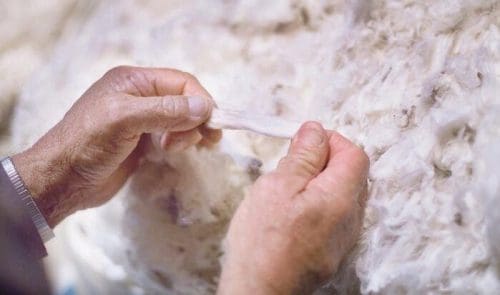 AUSTRALIA’s wool auction market held general steady this week, with some improvement in medium and superfine Merino prices on the east coast, an overall lift in Fremantle sale values and lower crossbred fleece prices.
AUSTRALIA’s wool auction market held general steady this week, with some improvement in medium and superfine Merino prices on the east coast, an overall lift in Fremantle sale values and lower crossbred fleece prices.
The Australian Wool Exchange said the market was on track to record a second successive increase before a weak finish on the final selling day reversed the rises.
Brokers offered 44,147 bales, up 3923 bales, with brokers passing in 10.6 percent.
“On the opening day in the east the movements in the merino fleece Micron Price Guides (MPGs) were varied, ranging between -14 and + 25 cents,” AWEX said.
“The AWEX Eastern Market Indicator gained two cents for the day.”
On the second day, AWEX said the market continued to trade at very similar levels and the movements in the MPGs for 18 micron and coarser were small, between unchanged and +9 cents, with the EMI gaining another two cents.
“On the final day, only Melbourne was in operation and despite a solid opening the market weakened as the day progressed.
“The MPGs for 20 micron and finer lost between 2 and 23 cents, with only the 21 micron MPG remaining unchanged,” AWEX said.
“The EMI lost the four cents gained over the previous two days.
The EMI closed the week unchanged at 1318 cents/kg clean,” AWEX said.
“The Fremantle sales were again the best performers for the second week in a row.
“In the west, the Merino fleece MPGs added between 11 and 29 cents for the series, and the increases pushed the MPGs for 19, 19.5 and 20 micron above the closing levels of the eastern centres.”
AWEX said the crossbreds were the poorest performing sector in percentage terms this week.
“The crossbred MPGs (26 to 32 micron) fell by between 5 and 13 cents, with only the 28 micron MPG in the north not recording a fall.
“The largest drops were in Melbourne, here the 28 and 30 micron MPGs both fell by 4pc.”
Demand improved for fine and medium Merino wool – AWI
Australian Wool Innovation trade consultant Scott Carmody said demand improved for fine and medium Merino wool at the auctions, despite the major indicator showing an unchanged value.
“There were some notable moves in those individual Merino sectors, highlighted by the handy 20 to 30-cent gains of the Western Australian quoted Merino types of mainly 19 to 21 micron.
“That (Fremantle) centre is currently providing a good portion of those regularly traded China types with lower vegetable matter (VM) levels, the prime attraction to completing exporters’ orders alongside other tested readings.
“The quality of the eastern Australian offering was responsible for holding or depreciating prices in those two selling centres,” Mr Carmody said.
“In fact, within each micron grouping, the easier to place sale lots with attractive results were dearer for the week, but the sub-par types lowered more than the better types gained so an overall loss was recorded within some sectors.
“This was particularly in play on the final day of selling at the stand-alone Melbourne sale whereby a larger percentage of the harder to place lots were offered and price falls were felt across the board,” he said.
Mr Carmody said local exporters were the primary buyers this week, with some back-to-back weeks of trading opportunities providing renewed confidence for them to step in to fully support the market whilst continuing to juggle finances.
“With one keen eye on the upcoming single week recess in auction sales to provide some financial relief, there is a growing positive sentiment amongst buyers for the bettering fortunes of the market, particularly if logistics improve, offered quantities lower and quality improves.
“Within the Merino sectors, Chinese buying remains dominant, but the ongoing interest from the Indian sub-continent and Europe has an important role in maintaining price levels and providing some impetus for potential improvement of the grower returns,” Mr Carmody said.
“The orders may be sporadic and less in volume from these destinations, but the impact they have on the auction scene is key, in addition to the alternate and viable manufacturing bases for wool textiles they provide.
“The crossbred wool types have remained reasonably stable since the New Year, with predominantly Chinese buying holding the levels,” he said.
“This week saw the first comprehensive price falls for some weeks albeit just 15 cents, but that is a large percentage given the low price base at present.”
Next week’s national offering is forecast to climb to 52,724 bales in Sydney, Fremantle and Melbourne, which was restricted to two days selling, due to the Good Friday Public Holiday.
Click here to the see the latest AWEX Micron Price Guides.
Sources – AWEX, AWI.



HAVE YOUR SAY